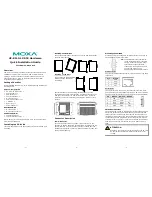
14
MAINTENANCE
HPRS Series
Chapter 5
MAINTENANCE
5.1 Preventive Maintenance
The
HPRS
Decade Substituter is packaged in a ven-
tilated case. If it is maintained in a generally clean
or air-conditioned environment, cleaning will seldom
be necessary. In a contaminated atmosphere, cleaning
may be required.
To maintain optimal accuracy and stability, it is best
not to open the case of the unit. In normal service,
the switches require no additional lubrication. Dur-
ing the manufacturing process, a light lubrication is
applied which in most instances is suffi cient for the
service life of the switches, and yet will not tend to
collect dust.
5.2 Verifi cation of Performance
5.2.1 Calibration Interval
The HPRS Series instruments should be verifi ed for
performance at a calibration interval of twelve (12)
months. This procedure may be carried out by the
user, if a calibration capability, is available, by IET
Labs, or by a certifi ed calibration laboratory. If the
user should choose to perform this procedure, then
the considerations below should be observed.
5.2.2 General Considerations
It is important, whenever testing the
HPRS
Series
Decade Units, to be very aware of the capabilities
and limitations of the test instruments used. There
are a some bridges and direct reading resistance me-
ters or digital multimeters available that can verify
the accuracy of these units,
especially
when used in
conjunction with standards that can serve to confi rm
or improve the accuracy of the testing instrument.
Such instruments would have to be
signifi cantly
more
accurate than the specifi ed accuracies for all appli-
cable ranges, in order to perform this task, allowing
for a band of uncertainty of the instrument itself. A
few commercial models, bridges and meters, do exist
that can do this; consult IET Labs for information.
It is important to allow both the testing instrument
and the HPRS Substituter to stabilize for a number of
hours at the nominal operating temperature of 23
0
C,
and at < 50% RH. There should be no temperature
gradients across the unit under test.
Proper metrology practices should be followed in
performing this verifi cation.
5.2.3 Procedure
1. Confi rm the zero resistance of the unit.
2. Determine the allowable upper and lower
limits for each resistance setting of each de-
cade following the specifi ed accuracy given
in the Specifi cations Section of Chapter 2.
3. Confi rm that the resistances fall within these
limits.
4.
If any resistances fall outside these limits, the
associated switch assembly may be trimmed,
repaired or replaced.



































